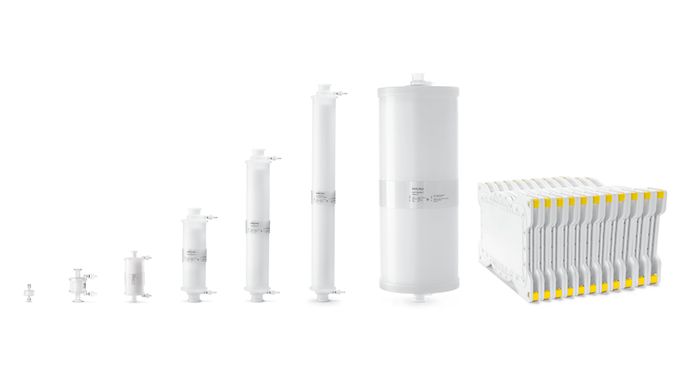
Sartobind® Phenyl Chromatography Membranes
Hydrophobic interaction chromatography (HIC) separates and purifies biomolecules based on differences in their hydrophobicity. The phenyl membrane adsorber follows the same principles as conventional hydrophobic interaction chromatography. Due to its large pore size, membrane adsorbers exhibit excellent flow properties. There are almost no mass transfer diffusion limitations compared to conventional bead chromatography. Buffers with high salt concentrations promote protein adsorption onto the hydrophobic membrane matrix. Proteins are eluted by reducing the salt concentration in the elution buffer.
The membrane's salt dependence is comparable to that of columns using ammonium sulfate, sodium chloride, and sodium citrate.
Application:
HIC is a powerful method for distinguishing target proteins from hydrophobic contaminants. Large proteins bind more strongly than smaller ones and aggregate significantly better than monomers due to multi-point attachment.
A high ionic strength buffer, typically ammonium sulfate, is first added to the protein solution. Salt ions in this solution reduce the solubility of dissolved substances in the sample. As solvation decreases, exposed hydrophobic regions bind to the hydrophobic membrane matrix. In the HIC membrane, flexible cellulose is used as a backbone for the phenyl ligand. The membrane can be regenerated using water or alcohol.
HIC Membrane used for the removal of:
- Aggregates
- Host cell proteins
- Viruses
- Endotoxins
- Lipids, dyes, detergents, and antifoaming agents
- Eluted chromatography ligands
The phenyl membrane can also be used for binding large proteins such as:
- Monoclonal antibodies
- Conjugated vaccines, viruses, and phages
- Oligonucleotides
Advantages:
HIC membranes offer the following benefits over conventional HIC columns:
- Excellent aggregate reduction
- 85% buffer savings
- 75% time savings
Ease of Use:
- Plug & play devices from 0.08 mL to 5 L
- Can be used as a filter
- Flow rate up to 5 bed volumes/min
- Reusable for >100 cycles or single-use


